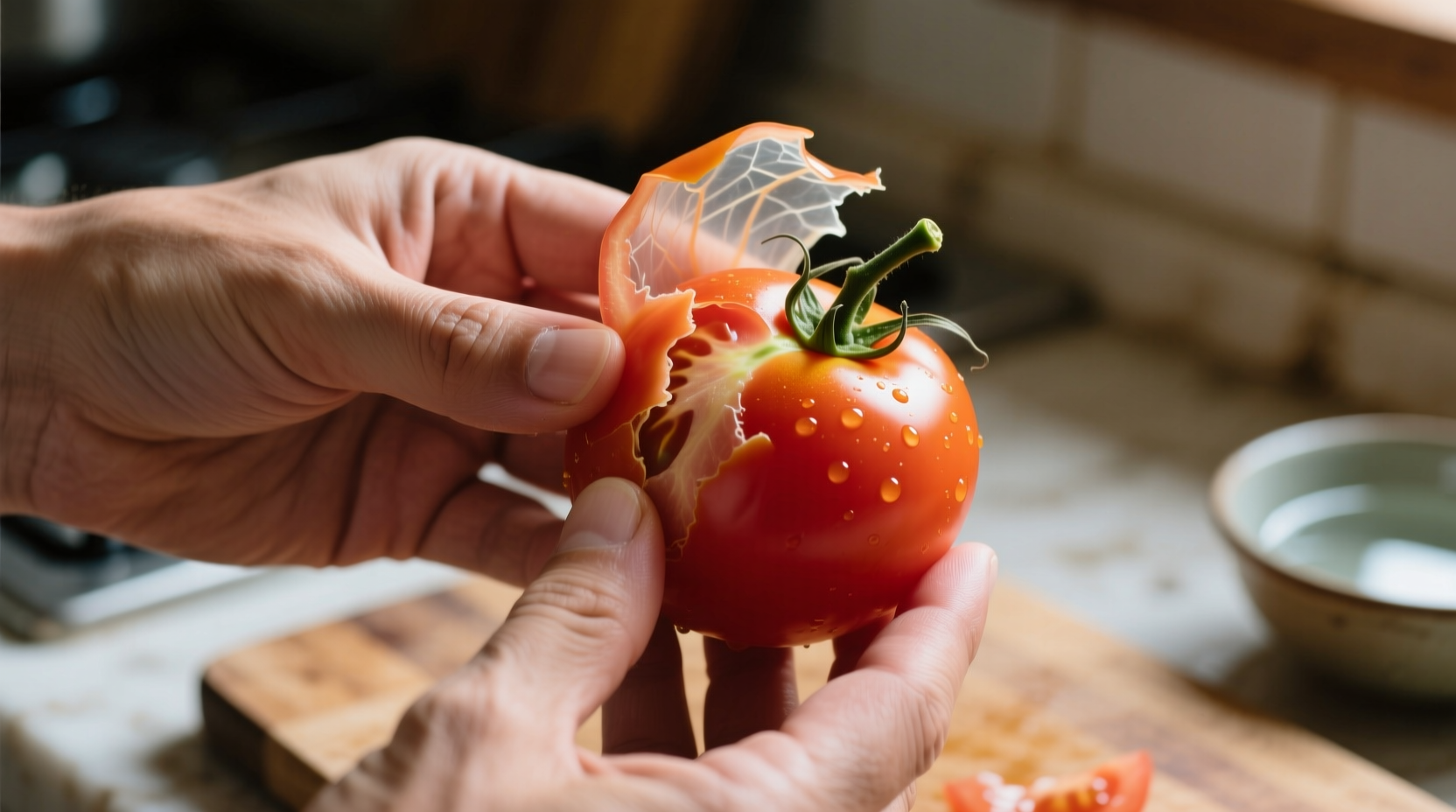The fastest, most reliable method to remove tomato skins is blanching: score tomatoes, boil for 30-60 seconds, then immediately transfer to ice water. The skins will slip off effortlessly, leaving perfectly peeled tomatoes ready for sauces, canning, or freezing.
Peeling tomatoes might seem like an unnecessary step, but it transforms dishes where texture matters. Whether you're making silky tomato sauce, smooth soup, or preserving summer's bounty, removing tomato skins prevents tough, bitter bits that can ruin your final dish. Professional chefs and home cooks alike rely on this simple technique to elevate their recipes.
Why Peel Tomatoes? The Science Behind Skin Removal
Tomato skins contain tough cellulose fibers that don't break down during cooking. When making sauces or soups, these fibers create an unpleasant texture and can impart a slightly bitter flavor. According to the USDA Food Safety and Inspection Service, properly prepared tomatoes also reduce potential surface contaminants before consumption.
| Method | Time Required | Best For | Skin Removal Success Rate |
|---|---|---|---|
| Blanching | 5-10 minutes | Immediate use, sauces, canning | 95-100% |
| Roasting | 30-45 minutes | Flavor enhancement, soups | 85-90% |
| Freezing | 24+ hours | Make-ahead, large batches | 80-85% |
The Blanching Method: Professional Results in Minutes
Blanching remains the gold standard for tomato skin removal. This technique has evolved from traditional European preserving methods to become the go-to approach in modern kitchens. The process works because the hot water breaks down pectin between the skin and flesh, while the rapid cooling causes the skin to contract faster than the flesh.
- Prepare your station: Fill a large pot with water (enough to cover tomatoes), bring to rolling boil. Prepare large bowl of ice water.
- Score tomatoes: Using a sharp knife, make a shallow "X" on the bottom of each tomato (this helps skin peel back evenly).
- Blanch: Lower 2-3 tomatoes into boiling water for 30-60 seconds (timing depends on tomato size and ripeness).
- Shock: Immediately transfer tomatoes to ice water using slotted spoon. Let sit 1-2 minutes.
- Peel: Starting at the "X," gently pull skin away from flesh. It should come off in large pieces.
Pro tip: Work in small batches to maintain water temperature. Over-blanching (more than 60 seconds) can start cooking the tomato flesh.

Alternative Methods for Special Situations
Roasting Method (For Flavor Enhancement)
When you want deeper flavor along with peeled tomatoes, roasting works beautifully. This method is particularly useful for sauces where caramelized notes are desirable.
- Preheat oven to 400°F (200°C)
- Place whole tomatoes on baking sheet
- Roast 20-30 minutes until skins blister and pull away from flesh
- Remove from oven and let cool slightly
- Peel skins starting from any loose edges
When to choose this method: Making roasted tomato soup, marinara sauce, or when you want concentrated tomato flavor. According to America's Test Kitchen research, roasting increases umami compounds by up to 30% compared to raw tomatoes.
Freezing Method (For Large Batches)
When you have abundant tomatoes and want to peel them later, freezing offers a hands-off approach.
- Wash and dry tomatoes thoroughly
- Place on baking sheet in single layer
- Freeze until solid (about 4 hours)
- Transfer frozen tomatoes to container
- When ready to use, run under warm water for 10-15 seconds
- Skin should slip off easily
Important limitation: Freezing changes tomato texture, making them better suited for cooked applications rather than fresh eating. This method works best with firm, ripe tomatoes.
Troubleshooting Common Tomato Peeling Problems
"The skin won't come off!" - What to Do
- Under-blanched: Return to boiling water for 15-20 more seconds, then re-shock
- Overripe tomatoes: Handle extra gently; use smaller batches in boiling water
- Very thick-skinned varieties: Extend blanch time by 10-15 seconds
Preserving Your Peeled Tomatoes
Once peeled, tomatoes can be:
- Used immediately: Best for sauces and soups
- Refrigerated: Store in airtight container for 2-3 days
- Freezed: Place on baking sheet, freeze solid, then transfer to freezer bags (keeps 10-12 months)
- Canned: Process in water bath canner following National Center for Home Food Preservation guidelines
Which Method Should You Choose? Context Matters
Your choice depends on your end goal and timeline:
- For quick sauce preparation: Blanching delivers perfect results in minutes
- For depth of flavor: Roasting adds complexity but takes longer
- For seasonal abundance: Freezing allows processing large quantities with minimal effort
- For canning: Blanching preserves texture better than roasting
Remember that cherry and grape tomatoes have proportionally thicker skins, requiring slightly longer blanch times (45-75 seconds). Heirloom varieties often have more delicate flesh, so handle them gently after blanching.
Putting It All Together: Your Tomato Peeling Roadmap
Follow this decision tree for perfect peeled tomatoes every time:
- Determine your end use (sauce, soup, canning, freezing)
- Assess your time constraints (immediate use vs. make-ahead)
- Consider tomato variety and ripeness
- Choose method based on these factors
- Follow precise timing for your selected method
- Store properly for your intended use
Mastering tomato skin removal unlocks restaurant-quality results at home. With these techniques, you'll never have to compromise on texture again. The blanching method remains the most versatile approach, working equally well for small batches or large canning projects. Remember that properly peeled tomatoes make the difference between a good sauce and a truly exceptional one.











 浙公网安备
33010002000092号
浙公网安备
33010002000092号 浙B2-20120091-4
浙B2-20120091-4